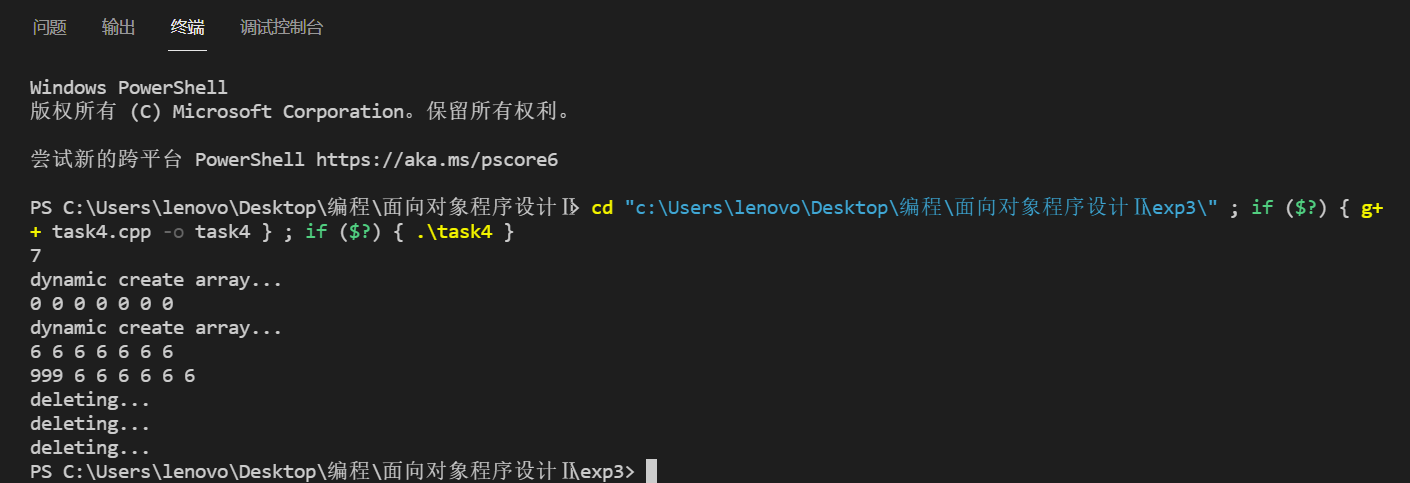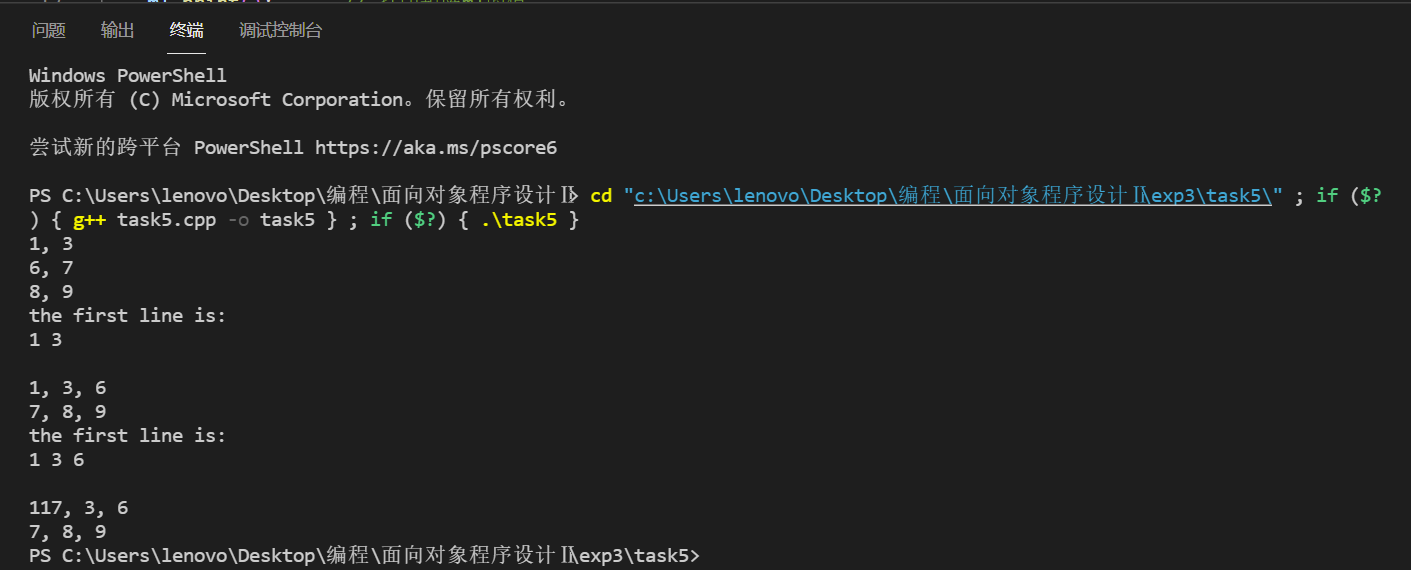实验3 类和对象Ⅱ
四、实验结论
1.实验任务1-3
验证性实验。
2.实验任务4
-
动态int型数组类Vector_int的定义实现源码(vector_int.hpp)
#ifndef VECTOR_HPP #define VECTOR_HPP #include <iostream> #include <cassert> using namespace std; class Vector_int { public: Vector_int(int n); Vector_int(int n, int value); Vector_int(const Vector_int &x); ~Vector_int(); int &at(int index); void show() const; private: int size; int *p; }; Vector_int::Vector_int(int n) : size(n) { cout << "dynamic create array..." << endl; p = new int[n](); } Vector_int::Vector_int(int n, int value) : size(n) { cout << "dynamic create array..." << endl; p = new int[n]; for (auto i = 0; i < n; i++) { p[i] = value; } } Vector_int::Vector_int(const Vector_int &x) : size(x.size) { p = new int[size]; for (auto i = 0; i < size; ++i) p[i] = x.p[i]; } Vector_int::~Vector_int() { cout << "deleting..." << endl; delete[] p; } int &Vector_int::at(int index) { assert(index >= 0 && index < size); return p[index]; } void Vector_int::show() const { for (int i = 0; i < size; i++) { cout << p[i] << ' '; } cout << endl; } #endif -
测试类Vector_int的代码(文件task4.cpp)
#include <iostream> #include "vector_int.hpp" using namespace std; int main() { int n; cin >> n; Vector_int x1(n); x1.show(); Vector_int x2(n, 6); x2.show(); Vector_int y(x2); y.at(0) = 999; y.show(); return 0; } -
运行测试结果截图
![]()
3.实验任务5
-
类Martrix的定义和实现完整代码(Matrix.hpp)
#ifndef MATRIX_H #define MATRIX_H #include <iostream> #include <cassert> using namespace std; class Matrix { public: Matrix(int n); // 构造函数,构造一个n*n的矩阵 Matrix(int n, int m); // 构造函数,构造一个n*m的矩阵 Matrix(const Matrix &X); // 复制构造函数,使用已有的矩阵X构造 ~Matrix(); // 析构函数 void set(const double *pvalue); // 用pvalue指向的连续内存块数据为矩阵赋值 void set(int i, int j, int value); // 设置矩阵第i行第j列元素值为value double &at(int i, int j); // 返回矩阵第i行第j列元素的引用 double at(int i, int j) const; // 返回矩阵第i行第j列元素的值 int get_lines() const; // 返回矩阵行数 int get_cols() const; // 返回矩列数 void print() const; // 按行打印输出矩阵 private: int lines; // 矩阵行数 int cols; // 矩阵列数 double *p; // 指向存放矩阵数据的内存块的首地址 }; // 类Matrix的实现: Matrix::Matrix(int n) : lines(n), cols(n) { p = new double[n * n]; } Matrix::Matrix(int n, int m) : lines(n), cols(m) { p = new double[n * m]; } Matrix::Matrix(const Matrix &X) : lines(X.lines), cols(X.cols) { p = new double[lines * cols]; for (auto i = 0; i < lines * cols; i++) p[i] = X.p[i]; } Matrix::~Matrix() { delete[] p } void Matrix::set(const double *pvalue) { for (auto i = 0; i < lines * cols; i++) p[i] = pvalue[i]; } void Matrix::set(int i, int j, int value) { assert(i >= 0 && i < lines && j >= 0 && j < cols); p[i * cols + j] = value; } double &Matrix::at(int i, int j) { assert(i >= 0 && i < lines && j >= 0 && j < cols); return p[i * cols + j]; } double Matrix::at(int i, int j) const { assert(i >= 0 && i < lines && j >= 0 && j < cols); return p[i * cols + j]; } int Matrix::get_lines() const { return lines; } int Matrix::get_cols() const { return cols; } void Matrix::print() const { for (int i = 0; i < lines; i++) { for (int j = 0; j < cols; j++) { cout << p[i * cols + j]; if (j != cols - 1) cout << ", "; } cout << endl; } } #endif -
测试代码(task5.cpp)
#include <iostream> #include "matrix.hpp" int main() { using namespace std; double x[] = {1, 3, 6, 7, 8, 9}; Matrix m1(3, 2); // 创建一个3×2的矩阵 m1.set(x); // 用一维数组x的值按行为矩阵m1赋值 m1.print(); // 打印矩阵m1的值 cout << "the first line is: " << endl; cout << m1.at(0, 0) << " " << m1.at(0, 1) << endl; cout << endl; Matrix m2(2, 3); m2.set(x); m2.print(); cout << "the first line is: " << endl; cout << m2.at(0, 0) << " " << m2.at(0, 1) << " " << m2.at(0, 2) << endl; cout << endl; Matrix m3(m2); m3.set(0, 0, 117); m3.print(); } -
运行测试截图
![]()







 浙公网安备 33010602011771号
浙公网安备 33010602011771号